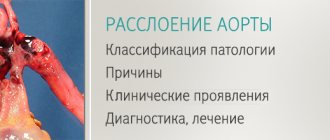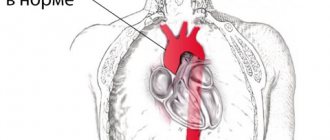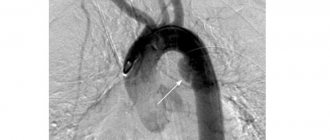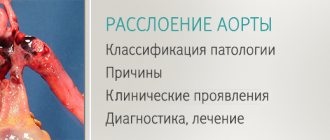Aortic rupture is accompanied by a violation of the integrity of the largest artery of the human body and the rapid release of large volumes of blood. This vascular accident is rightfully ranked among the ten most dangerous life-threatening conditions, and it ends in death in 90% of cases. In case of aortic rupture, even a timely operation does not always end successfully, and the probability of the patient’s death remains extremely high.
Observations by cardiologists show that in recent years, the frequency of rupture of this largest vessel has begun to occur several times more often, and saving the patient in these cases is possible much less often than with myocardial infarction, strokes and other vascular pathologies. In most cases, the vascular catastrophe discussed in this article occurs against the background of atherosclerosis, inflammatory or degenerative lesions of the vessel.
Why does aorta rupture? What pathologies and diseases contribute to its rupture? What external factors can affect the likelihood of this pathology? What are the symptoms of this vascular catastrophe? How to identify a threat of aortic rupture? What treatment methods are used for its rupture? What is the prognosis for patient survival after aortic rupture?
Along the razor's edge
An aneurysm, that is, an expansion of the walls of the aorta, is a condition that precedes the rupture of a blood vessel. A person suffering from this disease risks his life every second, since a “hole” in the aorta inevitably entails a quick (within 1-3 minutes) death.
The danger of this disease is that it can occur without any symptoms. If there are signs of this disease, they depend mainly on the location of the aneurysms.
A thoracic aortic aneurysm occurs when the dilated vessel begins to compress neighboring organs. Deep chest pain, shortness of breath, hoarseness, hemoptysis, and dry cough may occur.
The vast majority of aneurysms that occur in the thoracic and thoraco-abdominal aorta are congenital anomalies of the connective tissue that makes up the vessel. The aorta in such patients is thin, with a bluish tint, weak to rupture, and practically under the surgeon’s hand it exfoliates and crumbles. It is problematic to live to old age with such a blood vessel, so the need for surgery arises already at a young age (from 20 to 40 years).
An abdominal aortic aneurysm in 40% of cases is an accidental finding during clinical or radiological examination, since its symptoms are mild. The patient may notice periodic pain in the abdomen or back without clear localization and a feeling of pulsation.
Dilatation of the abdominal aorta usually causes atherosclerosis. The vessel loses its elasticity, calcium settles on its walls, making the inner surface of the aorta look like sand or buckwheat. Atherosclerosis is provoked by elevated blood cholesterol levels, diabetes mellitus, high blood pressure, stress, and belonging to the stronger sex (¾ of patients are men).
Surgical interventions
Surgical treatment is recommended for aneurysm sizes of 5.6 cm or more. If you have Marfan syndrome, other connective tissue diseases, or a family history of an aortic aneurysm, your doctor may recommend surgery for even small aneurysms.
Depending on your condition and the location of the thoracic aortic aneurysm, your doctor will recommend:
- Open chest surgery. An operation to open the chest to treat a thoracic aortic aneurysm involves removing the damaged section of the aorta and replacing it with a synthetic tube (prosthesis), which is sewn in place of the removed section. This procedure requires opening the abdomen or chest, takes more than 4 hours and takes several months to fully recover.
- Endovascular intervention. Through a small incision in the groin area, a special stent graft is inserted into the area of the aortic expansion. After which the stent-graft is opened, its position is assessed and secured. The aortic stenting operation is performed in an angiographic operating room, lasts 1 – 1.5 hours and the recovery period takes approximately 1.5-2 weeks.
- Other heart surgeries. If you have a medical condition that contributes to the formation of an aneurysm, such as damage to the heart valves, your doctor will recommend additional surgeries to repair or replace damaged valves to prevent the aneurysm from getting worse.
Search and don't give up
A dissecting aneurysm (longitudinal rupture of the aorta) is practically asymptomatic. At the time of rupture of the vessel, the patient experiences severe “tearing” pain in the chest, which is often mistaken for symptoms of another cardiovascular disease, such as myocardial infarction. If prompt surgical measures are not taken, death after aortic rupture can occur within 2 hours.
In order not to lead to such a situation, you need to undergo examination on time. An ultrasound examination can detect an aneurysm even in cases where there is no dangerous dilation of the vessel yet, but it is about to appear. X-ray is very informative for an abdominal aneurysm, since it is clearly visible due to the deposition of calcium on the walls of the vessel. More detailed studies - computer and magnetic resonance imaging - are carried out after the ultrasound method. They allow you to determine the strategy for further treatment. It is believed that if the diameter of the aneurysm is less than 5 cm, the risk of rupture of the vessel is low. With larger sizes the risk increases.
Complications of aortic aneurysm
Very often, signs of an aortic aneurysm appear only with the development of complications of this disease. They can be divided into two groups: dissecting aneurysm or wall rupture with the development of bleeding and thrombosis.
Dissecting aortic aneurysm is accompanied by acute pain and rapidly occurring symptoms of internal bleeding. Blood can flow freely into the chest, abdominal cavity, pericardium, pleural cavity, and esophagus.
In the dilated area of the vessel, the normal flow of blood is disrupted, so conditions are created in it for the formation of blood clots - thrombi. Migrating through the bloodstream, such blood clots can cause blockage of important vessels with the development of stroke, myocardial infarction or internal organs, and arterial thrombosis of the lower extremities.
Replacing parts
Conservative treatment is used only in case of serious contraindications to surgical intervention (old age, presence of concomitant systemic diseases, etc.). The most commonly used surgical methods.
Implantation of a synthetic prosthesis. The artificial vessel has good biocompatibility and can exist in the body for an unlimited time. Carrying out this operation requires the surgeon to have the highest professionalism and mastery of technique. It is most difficult to operate on thoracic and thoraco-abdominal aneurysms, since these rather lengthy and complex surgical procedures are carried out under conditions of artificial circulation. Abdominal surgery is performed for all types of aneurysm, but a less traumatic method of treatment can be used on the abdominal aorta.
Stenting method. By puncture of the femoral artery, a metal stent covered with a special fabric is inserted into the aorta. Opening in the aorta, it strengthens the walls of the vessel and protects it from rupture. After surgery, the patient must maintain normal blood pressure at all times and avoid excessive strain.
Treatment of aortic aneurysm at the clinic on Barclay
Advantages of observation, diagnosis and treatment of patients with aortic aneurysm in our center:
- Experienced cardiologists, functional diagnostics and ultrasound doctors receive patients here;
- Expert-class equipment is used to increase diagnostic accuracy;
- complex treatment of concomitant diseases is possible, recommendations for the correction of risk factors;
- Affordable prices for medical services are offered.
If you suspect a disease or have already diagnosed an aneurysm, we invite all patients living in Moscow for a consultation with our specialists. To make an appointment, you need to call the phone number provided.
Interesting
According to a study by American scientists, residents of the countries of Eastern Europe and the former USSR began to suffer from obesity after the economies of their countries switched to market economy. At the same time, there are now noticeably fewer obese people in Western Europe. This problem most affected Hungary (19%), Russia and Lithuania (18% each).
The main reasons for gaining extra pounds were: >> psychological stress associated with reforms;
>> change in working hours (the number of people engaged in office work and computer work has sharply increased);
>> expansion of fast food chains;
>> the emergence of numerous stores selling cheap packaged foods (chips, cookies) that are convenient to eat on the go;
>> mass motorization of the population.
Prognosis for pathology
If the aorta ruptures completely, the prognosis is extremely poor: about 90% of patients die. This is due to the following factors:
- untimely arrival of ambulance;
- incorrect diagnosis;
- too much hemorrhage in vital organs, for which even surgery may not help;
- severe tolerance of general anesthesia and surgery in older people.
With earlier stages of dissection, the chances of survival are much higher, especially if you see a doctor right away. Surgery guarantees recovery, but the risks associated with the operation itself remain.
By the way
Everyone knows that disease is easier to prevent, but rarely does anyone follow this rule. Over the years, a person begins to need to be more attentive to his health, especially paying attention to the heart and blood vessels, because it is no secret that cardiovascular diseases are in first place all over the world.
Giving up bad habits such as smoking and alcohol, eating foods rich in vitamins, and daily walks in the fresh air are all prerequisites for a healthy lifestyle and the prevention of cardiovascular diseases.
Unfortunately, every year it becomes more and more difficult for a city dweller to follow these seemingly simple rules. The air cannot be called fresh, and the food is not so rich in vitamins. In such conditions, the body is constantly in a state of stress.
Multivitamin preparations often help to resist the vagaries of the weather, improve your well-being, and prolong the active period of your life. They make up for the deficiency of vitamins and microelements that do not enter the body in sufficient quantities. In mature and old age, special attention should be paid to complexes with vitamins C and E (primarily due to their antioxidant properties), as well as B vitamins, which play a significant role in the functioning of the cardiovascular system. Complexes that, in addition to these vitamins, also include microelements such as selenium and magnesium can significantly increase the effect of taking them.
Introduction
When the aorta ruptures (dissection), complete or partial damage occurs to one, two or all three layers of the walls of this vessel. The reasons for this phenomenon are chronic diseases of the aorta. A complete rupture is a very dangerous pathology that requires urgent medical attention. If treatment is not started immediately, the disease leads to death.
At the first symptoms of dissection of this vital vessel, contact an angiosurgeon. If it is not available in your hospital, then go to a regular surgeon. Also get checked regularly if you suffer from diseases that lead to dissection. It is better to prevent the disease than to try to cure it, since with a complete rupture of the aorta, even medical care often does not have the expected effect.
Sometimes, for example, with a slow chronic rupture of the aorta, surgery can be completely cured, but in general this pathology has an unfavorable prognosis.
Useful information from anatomy
In connection with the above, the expression “rupture of the aorta or an aneurysm formed on it” sounds frightening.
Therefore, it is not surprising if the reader is interested in the question of where the aorta is located, what it is, as well as what an aneurysm is and what factors can provoke its rupture. The human circulatory system originates from a rhythmically contracting muscular organ that acts on the principle of a pump. This organ was called the heart and its purpose is to ensure continuous blood circulation, which delivers oxygen and nutrients to all human organs.
The large blood vessels communicating with the heart are divided into arteries and veins. The former drain blood from the heart, the latter are responsible for supplying blood to the central organ of the circulatory system. The largest human artery is the aorta, which is part of the systemic circulation, which supplies blood to the entire body, while the small one is responsible only for the blood supply to the pulmonary system.
The aorta, which emerges from the left ventricle of the heart and is a kind of continuation of it, can be compared to a pump hose. This large artery is long and extends along the entire human body.
It is customary to distinguish 3 main sections of the aorta:
- ascending (originates in the left ventricle of the heart and debuts from the dilated part called the bulb),
- aortic arch (starts somewhere on the seventh centimeter of the vessel, has a curved shape),
- descending (in the area of the 4th thoracic vertebra the arch becomes a straight line).
The ascending aorta is hidden behind the pulmonary trunk, the artery that begins the pulmonary circulation, and is covered by the pericardium. The diameter of the artery in this part is about 2.5-3 cm.
At the junction of the second costal cartilage and the sternum (the main bone of the chest), the aorta narrows to 2 cm and takes on the appearance of an arch, turning slightly to the left and back. Reaching the fourth thoracic vertebra, it forms a small isthmus, after which its position becomes almost vertical.
The descending aorta is in turn divided into 2 sections:
- thoracic region, which is located in the chest cavity in the posterior mediastinum,
- the abdominal section, which is considered a continuation of the thoracic and begins at the level of the 12th thoracic vertebra.
The initial section of the thoracic aorta is located in the anterior-left location of the esophagus. Further, in the region of the 8th vertebra, it bends around the esophagus on the left side and rushes down along the posterior wall of the esophagus.
The beginning of the abdominal region is considered to be the aortic opening of the diaphragm. Diving into this hole, the aorta stretches to the 4th lumbar vertebra.
Along the course of the aorta, branches of various sizes branch off from it - arteries. In the ascending section these are the right and left coronary arteries. In the area of the aortic arch originate:
- brachiocephalic trunk, which in turn is divided into the right carotid and subclavian arteries,
- left common carotid and subclavian arteries.
The descending part is divided into the thoracic region, in which the intercostal, tracheal and many other types of arteries begin, and the abdominal. From the abdominal region come:
- the celiac trunk, which after a couple of centimeters is divided into the left gastric, common hepatic and splenic arteries,
- mesenteric blood vessels responsible for the blood supply to the intestines and pancreas,
- low phrenic artery, supplying the diaphragm and adrenal glands,
- adrenal artery
- lumbar arteries,
- renal artery.
In the region of the 4-5 lumbar vertebrae, the abdominal part of the aorta is divided into 2 parts (its bifurcation occurs): the right and left common iliac arteries, the continuation of which is the femoral arteries.
Weakening of the walls of large blood vessels that experience maximum blood pressure can occur in any part of the aorta or arteries branching from it. Overstretching of the walls of the aorta leads to the fact that in this place they become weaker and prone to rupture. Rupture of an aortic aneurysm or arteries branching from it is dangerous in any case. But the prognosis in this case depends on many factors: the location of the aneurysm, its shape and size, the degree of damage to the arterial walls.
Causes
People who care about the health of their cardiovascular system are interested in the question of why an aneurysm ruptures, and what are the factors contributing to the development of this vascular pathology? A person can live for many years and not realize that he has an aneurysm of any vessel.
The insidiousness and danger of this disease lies precisely in the fact that it occurs without any manifestations. But at the same time, the patient risks his life every second, since the vessel can rupture at any moment, and in a couple of minutes the person will die.
A patient diagnosed with aortic dissection should avoid vigorous physical activity, as there is a very high probability that this will provoke a rupture. In other similar situations, when the load on the heart increases, the pressure rises, the heart rate increases, and the risk of aneurysm rupture increases significantly.
”alt=””>
Factors that provoke aneurysm include the following:
- hypertensive crisis;
- significant physical activity;
- bearing a child.
Aortic rupture occurs due to the gradual thinning of its walls, which is caused by:
- Atherosclerosis - the aorta changes due to the formation of plaques, narrowing the lumen in the vessel and weakening its walls.
- Aortitis is a disease accompanied by inflammation of the largest vessel.
- Marfan syndrome is a congenital pathology of connective tissue.
- Infectious diseases that gradually destroy blood vessels (tuberculosis, syphilis, etc.).
- Hereditary factor.
- Injuries to the chest and peritoneum.
Pregnant women, men over 60 years of age, and people who engage in intense sports are also at risk.
The main blood vessel that transports blood saturated with oxygen and various nutrients is the aorta. It originates from the heart and, under great pressure, drives blood to all organs of the human body.
In a healthy person, blood vessels are elastic and resilient, ensuring unhindered blood flow to its destination.
Sudden rupture of an aortic aneurysm is almost always fatal. The causes of rupture of an aneurysm of the main blood vessel include:
- atherosclerotic damage to the walls of the aorta;
- hereditary pathologies of connective tissue;
- high blood pressure;
- infected thrombus formation;
- the last stage of syphilis;
- age-related changes;
- smoking;
- intense physical activity;
- long-term stressful conditions;
- chest or abdominal injuries;
- diabetes;
- pregnancy and labor;
- excess weight and sedentary lifestyle.
Death as a result of aortic rupture is caused by aneurysm dissection. The mechanism of its formation is as follows.
Due to the decrease in collagen structures, the integrity of the inner and middle membranes of the aorta is gradually compromised. The blood flow is restrained for some time by the last, outer shell of the vessel, when damaged, a rupture occurs.
”alt=””>
The myocardial muscle is very strong and elastic, so it cannot burst on its own.
Aortic rupture: causes and development, symptoms, how to avoid death, surgery, prognosis
© Author: A. Olesya Valerievna, candidate of medical sciences, practicing physician, teacher at a medical university, especially for SosudInfo.ru (about the authors)
Aortic rupture is a severe vascular pathology, one of the ten most life-threatening conditions. The mortality rate from aortic rupture reaches 90%, and even timely surgical intervention is not always successful.
According to statistics, over the past few decades, the frequency of ruptures of the main vessel of the human body has increased 7 times. Saving a patient with this condition is disproportionately more difficult than with many other potentially fatal diseases - myocardial infarction, cerebral hemorrhage, etc. While it is quite possible to diagnose changes in the aorta that could lead to rupture, modern medicine is still powerless to prevent them.
The aorta is the largest and, without exaggeration, the main vessel of the human body, which, delivering blood to all internal organs without exception, experiences a huge load, and the volume of blood flowing through the aorta every minute is quite large. Working continuously and with great stress, the aorta is subject to various kinds of pathological changes, but the real problem of recent decades has been atherosclerosis, which selects the aorta as the main target for damage.
When talking about aortic rupture, we usually mean a violation of the integrity of the vessel against the background of an aneurysm, the cause of which is atherosclerosis, degenerative changes, and inflammatory processes. In this regard, the greatest attention will be paid to the problem of a ruptured aneurysm of this vessel.
Atherosclerosis affects all parts of the aorta, but it is most active in the abdominal part, where the blood flow velocity is high, and due to the departure of large arterial trunks, turbulent blood flows are formed, which contribute to constant injury to the inner layer (intima) of the vessel. Lipid plaques destroy the aortic wall, deform and thin it, and the deposition of calcium salts makes the vessel very fragile and vulnerable. With progressive atherosclerosis against the background of high blood pressure, the lumen of the artery increases and an aneurysm occurs. Atherosclerotic aneurysms of the abdominal part account for up to 95% of cases of vessel dilatation.








